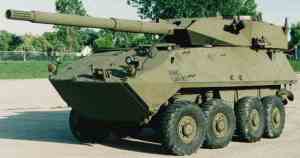| Designation: | LAV-Assault Gun |
 |
|---|---|---|
| Manufacturer: | Textron Marine & Land Systems | |
| Product type: | Armoured Vehicles | |
| Name: | Reconnaissance Vehicle |
In December 1988, the US Marine Corps approved a requirement for an LAV-AG and selected the Benet Laboratory 105 mm XM35 gun as the Government Furnished Equipment (GFE) weapon.
Following competitive bidding, in mid-1990 Cadillac Gage was selected to develop the Assault Gun Version of the LAV to meet the requirements of the US Marine Corps.
Under the terms of the original fixed-price Full-Scale Engineering Development (FSED) 40 month contract, Cadillac Gage was to build three vehicles for delivery by May 1992 to the US Marine Corps for Development and Operational Testing.
Late in 1991 however, the US Marine Corps cancelled the research and development phase of the LAV-105 due to lack of production funding between FY93 and FY96 as Pentagon acquisition policy did not allow continued development of a programme unless there was assured production money.
At the time of cancellation, the LAV-105 was on time and within the fixed-price budget with first unmanned firings already completed.
In mid 1993, the US Navy released US$33.8 million to allow Cadillac Gage to complete development and testing of the three prototypes of the LAV-105.
In June 1995, Cadillac Gage (now Textron Marine & Land Systems) completed development of the 105 mm Light Armored Vehicle - Assault Gun (LAV-AG) for the US Marine Corps, although there is currently no funding for production vehicles.
The company is continuing to market the LAV-AG on the international market, especially the Middle East, and the turret is also being offered for installation on other chassis, wheeled and tracked.
Textron Marine & Land Systems has leased the three prototype LAV-AG and their turrets from the US Marine Corps to enable marketing of the complete system and turret to continue.
The LAV-105 is essentially a new two-man turret designed by Cadillac Gage installed on an upgraded 8x8 chassis supplied by the Diesel Division, General Motors of Canada. The chassis is similar to that used for the standard LAV, described in the Armoured personnel carriers (wheeled) section under Canada, but has additional buoyancy aids fitted either side of the turret towards the rear and a different roof arrangement because there will be no hatches in the roof of the vehicle at the rear.
The all-welded steel turret is armed with a 105 mm Watervliet Arsenal M35 (development designation XM35 which is also installed in the now cancelled M8 Armored Gun System) lightweight gun which is fed from a bustle-mounted FHL automatic loader which holds eight rounds of ready use ammunition with additional rounds being carried in the hull.
The 105 mm gun is fitted with a muzzle brake and thermal sleeve and can fire all types of 105 mm ammunition including the latest Armour-Piercing Fin-Stabilised Discarding-Sabot (APFSDS) types. The empty cartridge cases are ejected out of the turret rear through a trap door.
A 7.62 mm M240 machine gun is mounted coaxially with the 105 mm gun and a bank of four electrically operated M257 smoke grenade launchers is mounted either side of the turret firing forward. Provision is made for the installation of a 7.62 mm or 12.7 mm machine gun on the turret roof.
The turret features an HR Textron (previously Cadillac Gage Control Systems) electromechanical gun/drive system in combination with a Computing Devices Canada digital fire-control computer.
Turret traverse is a full 360° with weapon elevation from -8 to +15°. Trials have shown that the LAV-AG can engage stationary and moving targets with a high first round hit probability while the vehicle itself is stationary or moving.
Both the commander and gunner are provided with a single-piece hatch cover that opens to the rear. The vehicle commander is seated on the left and has four day periscopes and a thermal day/night remote monitor. The gunner, seated on the right, has a stabilised Raytheon Day/Night Range Sight (DNRS), four observation sights and a back-up periscope.
The Raytheon DNRS comprises five key subsystems, Raytheon Infra-Red (HIRE) 240-line common thermal image with dual field of view. Raytheon laser rangefinder, Raytheon Line of Sight Stabilisation Platform (LSSP), commander's remote display for viewing the day and night sight images and with commander override for all the gunner's controls and the Line of Sight Electronics Unit (LOS-EU). The DNRS has a unity window and a x10 magnification narrow field of view for the day sight.
Development complete. Ready for production. No funded US Marine Corps requirement. Still being marketed by Textron Marine and Land Systems.
|
||||||||||||||||||||||||||||||||||||||||||||||||||||||||||
|
|||||||||||||||
